
Great Mid-Run Snacks to Improve Your Marathon
Posted on 03 Aug, 2020

The feeling of a long run is primal and transcendent, but so is that all-consuming, knee-trembling feeling of hunger and nausea that makes you desperate for food—while also questioning your ability to keep it down.
This is the challenge of the mid-workout meal: It needs to be full of energy and easy to digest. In fact, in the middle of a long run, many conventional dietary rules go out the window. Rather than protein and healthy fats, the body needs fast-absorbing carbohydrates—food that will spike insulin and send sugars rushing through the bloodstream to fuel the muscles that need them. "It's even a good idea to avoid more fibrous food, like sweet potatoes," says Greatist expert Jason Fitzgerald. "The fiber can exacerbate stomach cramps."
Mid-run snacking isn’t really necessary unless you’re exercising for more than hour. But if that’s the case, it’s good to start eating between 30 and 60 minutes in, at the rate of about 30 to 60 grams of carbohydrates per hour. Here's what you need to know.
Drinks
Okay, so they’re not normally considered a snack, but fluids can be a great way to quickly inject nutrients into the bloodstream.
1. Coconut Water
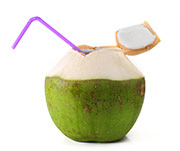 Sodium is one electrolyte the body sweats out, but there are many others. Coconut water gets the nod because it’s a great source of the “big five” electrolytes: calcium, sodium, magnesium, potassium, and phosphorous.
Sodium is one electrolyte the body sweats out, but there are many others. Coconut water gets the nod because it’s a great source of the “big five” electrolytes: calcium, sodium, magnesium, potassium, and phosphorous.
It’s also more easily digested than most sports drinks, so gulping coconut water is less likely to exacerbate the nausea brought on from a run.
[Check out: Is Coconut Water As Good As Everybody Claims It To Be?]
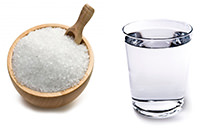 2. Water and Salt
2. Water and Salt
For a more "no-frills" approach, try simply adding a teaspoon of salt to your water bottle—it's an easy way to replenish the liquids and salts that are being foolishly excreted when they’re needed the most. It may seem counterintuitive, but during a run, salt can help maintain cardiovascular function and improve athletic performance.
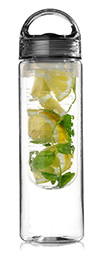 3. Flavored Water
3. Flavored Water
Want to level up your water? For some extra nutrients and carbs, take the water bottle and cram in fruit slices, berries, and herbs. Avoid drinking straight juice, though; it’s a little too high in fructose, a carbohydrate the body doesn’t process as well as other sugars. That may impair performance or interfere with fluid absorption.
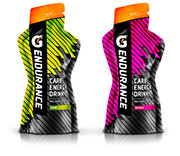 4. Sports Drinks
4. Sports Drinks
A 20-ounce bottle of Gatorade or Powerade contains about 35 grams of carbohydrates, and there's evidence that they help to prevent fatigue during exercise. For the purposes of distance running, Gatorade Endurance is probably a smart choice, as it contains twice the sodium and potassium of the regular brand.
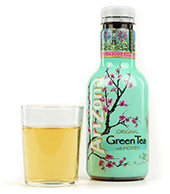 5. Iced Green Tea with Honey
5. Iced Green Tea with Honey
Honey contains more antioxidants than regular sugar and is a good source of potassium, which helps improve muscle function and reduce soreness. During a run, sipping on green tea can also improve endurance and increase VO2 max, which is the body’s ability to transport and use oxygen during exercise.
6. Sports Gels
Occupying a goopy place somewhere between liquid and food, runner’s gels are manufactured supplements that come in a tremendous variety of flavors and functions.
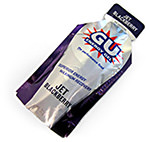 They tend to tick all the boxes: high in carbohydrates and electrolytes, fast digesting, and just the right ratio of fructose and maltodextrin, two sugars that, when working in tandem, can enhance athletic performance. Reasonably portable and tasty, there’s no real reason to avoid gels unless the cost is a deterrent, or you prefer the feeling of eating actual food.
They tend to tick all the boxes: high in carbohydrates and electrolytes, fast digesting, and just the right ratio of fructose and maltodextrin, two sugars that, when working in tandem, can enhance athletic performance. Reasonably portable and tasty, there’s no real reason to avoid gels unless the cost is a deterrent, or you prefer the feeling of eating actual food.
Actual Food
7. Bananas
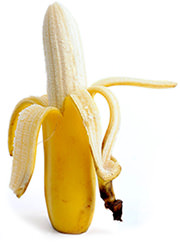 One medium banana contains nearly 30 grams of fast-digesting carbohydrates that can be just as effective as a carbohydrate drink in terms of performance, blood sugar, and oxidative stress. Don't throw out your old bananas, either—the riper the fruit, the simpler its sugars, and the faster it will be absorbed into the bloodstream.
One medium banana contains nearly 30 grams of fast-digesting carbohydrates that can be just as effective as a carbohydrate drink in terms of performance, blood sugar, and oxidative stress. Don't throw out your old bananas, either—the riper the fruit, the simpler its sugars, and the faster it will be absorbed into the bloodstream.
While bananas aren’t always super portable, they can always be mashed and carried in a Ziplock bag, or perhaps inside of a tortilla with a little cinnamon, which may reduce muscle soreness.
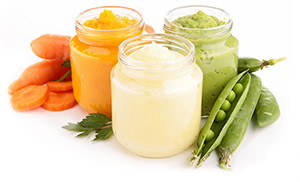 8. Baby Food
8. Baby Food
Its strengths are digestibility and portability: Baby food can be easily stored in pocket-friendly Ziplocks, and its mashed up consistency means some of the work of digesting is already done beforehand. This makes baby food a good way to quickly take in the sugars from fruit without losing as many nutrients as the juicing process. Buy some from the store or simply make it yourself from fresh, low-fat produce. Using a steamer or microwave is the best way to soften fruits and vegetables while preserving their vitamins. Afterwards, throw them in a food processor or mash them by hand.
9. Raisins
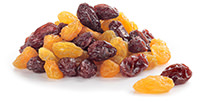 Dried fruit is a terrific choice in the middle of a run for the same reason it’s an iffy choice the rest of the time: they’re very high in calories and barely feel like you’re eating anything. In a recent study by Louisiana State University, raisins were found to be just as effective during endurance-based cardio workouts as sports jelly beans
Dried fruit is a terrific choice in the middle of a run for the same reason it’s an iffy choice the rest of the time: they’re very high in calories and barely feel like you’re eating anything. In a recent study by Louisiana State University, raisins were found to be just as effective during endurance-based cardio workouts as sports jelly beans
 10. Dates
10. Dates
Easy to chew and higher in simple sugars and carbohydrates than other dried fruit, dates are also a good source of potassium.
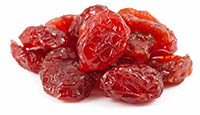 11. Dried Cherries
11. Dried Cherries
With more carbohydrates than any other fruit on this list, it’s somewhat unfortunate that cherries are high in fiber, since it slows digestion. Nonetheless, cherries may help to reduce muscle soreness caused by exercise—and after an hour of running, your legs might need all the help they can get!
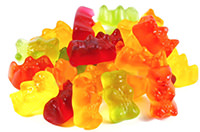 12. Gummi Bears
12. Gummi Bears
With lots of sugar and virtually no fat or fiber to slow their absorption, these candies are, astoundingly, not a terrible idea during a long run. Nonetheless, we’d prefer food that will bring at least some nutrients to the table.
13. Marshmallows
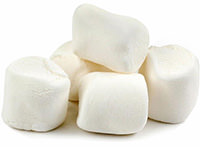 Last candy, we promise. Not only are marshmallows just as good (in all the bad ways) as gummi bears (or jellybeans, for that matter), but they're more portable. Sweaty hands can make it difficult to open a baggie, and leaving anything gummi in the pockets of a sweaty body on a hot day might result in a pocket full of sticky, inedible goo. If overheating is an issue, marshmallows might be the answer.
Last candy, we promise. Not only are marshmallows just as good (in all the bad ways) as gummi bears (or jellybeans, for that matter), but they're more portable. Sweaty hands can make it difficult to open a baggie, and leaving anything gummi in the pockets of a sweaty body on a hot day might result in a pocket full of sticky, inedible goo. If overheating is an issue, marshmallows might be the answer.
14. Homemade Energy Bars
This is a great way to combine several foods on this list. While it can be difficult to make bars that are in low in fat (nuts, coconut, and seeds tend to be staples), the servings are small enough that it’s not much of an issue. Play around with different combinations, but dates, figs, honey, and brown rice syrup are great binders, and sugary combos like Rice Krispies and marshmallow are totally allowed—just remember to approximate the amount of carbs per serving and to include plenty of salt.
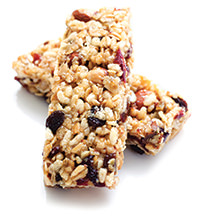 Also check out:
Also check out:
- Make Your Own "Chubby Hubby" Protein Bars
- Make Your Own Fudge Brownie Chocolate Protein Bars
- Make Your Own German Chocolate Protein Bars
- Make Your Own No Bake Almond Fudge Protein Bars
- Make Your Own Ginger Vanilla Protein Crunch Bars
- Make Your Own Quick And Easy No-Bake Protein Bars
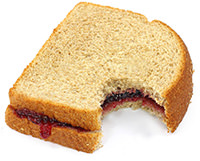 15. Jam/Honey Sandwich
15. Jam/Honey Sandwich
If the bread is white and there’s no fatty peanut butter slowing digestion, this is a delicious way to shuttle a lot of simple sugars into those aching calves. However, unless someone is waiting with a snack tray at the halfway mark, portability might be an issue.
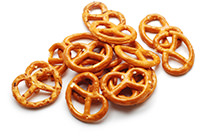 16. Pretzels
16. Pretzels
High in refined carbs and packing plenty of sodium, pretzels aren’t a bad choice for replenishing your energy and salt stores, particularly since they’re low in fiber and won’t take long to hit the bloodstream. As with candy, however it’s better to eat more natural foods that will supply some vitamins.
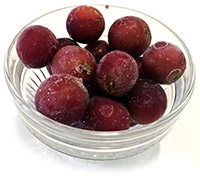 17. Frozen grapes
17. Frozen grapes
They’re easy to carry, high in sugar, relatively low in fiber, and refreshing as hell. Grapes are also a great source of vitamin C, which may increase the amount of fat burned and reduce exercise-related damage to the body’s cells.
What snacks do you use to refuel mid-run or mid-workout? Let us know below.
Photo Credits
Great Books On Nutrition For Runners

by Joanna Sayago Golub

by Shalane Flanagan

by Joanna Sayago Golub

by Matt Fitzgerald

 How To Taper For A Marathon
How To Taper For A Marathon A Case For Minimalist Footwear
A Case For Minimalist Footwear How Running Can Relieve Pain
How Running Can Relieve Pain Spectator Placards That Will Get You Running Faster
Spectator Placards That Will Get You Running Faster










